How to Recover Deleted Files on Your Mac: 8 Working Ways
Your Mac or MacBook is an incredible example of cutting-edge technology wrapped in an intuitive and user-friendly package. Unfortunately, no computer manufacturer, not even Apple, has been able to design a machine that is impervious to the problem of accidentally or inadvertently deleted data. There’s no computer on the market that can guarantee you’ll never lose some important files.
Quick & Easy Method: How to Recover Deleted Files on Mac:
- Open the Trash Bin icon on your Mac desktop
- Find the lost or deleted files that you wish to restore.
- Right-click on them and select the “put back” option to recover deleted files on Mac from the Trash.
- Congratulations! You have recovered deleted data on your Mac
| Problem | Solution | Probability of Success |
| I have recently deleted a file: | 🗑️ Check your Mac main Trash and secondary Trashes folders for the lost file. (Solution 1 | Solution 2 | Solution 3) | High |
| I have accidentally deleted an important file and it’s not in the Trash: | 💻 Try data recovery software or recovering from a backup. (Solution 5 | Solution 6 | Solution 7) | High |
| I formatted a disk accidentally: | 💻 Use data recovery software. (Solution 7) | High if done promptly after the format. |
| My Mac got a virus and I lost files: | 💾 Use data recovery software or recovering from a backup. (Solution 5 | Solution 6 | Solution 7) | Average |
| My Macbook is dead: | 👨🔧 Contact a data recovery service center. (Solution 8) | Depends on the condition of the drive. |
Is It Possible to Recover Permanently Deleted Files on Mac?
Yes, it is possible to recover permanently deleted files on a Mac, but it depends on several factors.
Firstly, if you have a backup of the deleted files, you can easily restore them from the backup media.
Secondly, if you don’t have a backup, but the files were only “permanently” deleted recently, there is a chance that they are still recoverable using a data recovery software. When you delete a file on a Mac, the operating system doesn’t immediately erase the data from the storage device. Instead, it marks the space as available for new data and removes the pointers that allow access to the file. Therefore, if the space hasn’t been overwritten by new data, it is possible to recover the deleted files using a data recovery software.
How to Recover Deleted Files on Mac
There are many ways to perform Mac file recovery. Some are simpler than others and can be done with a few clicks or keystrokes. Hopefully, one of the following methods will enable you to recover your valuable lost data.
Method 1: Recover Deleted Files from Trash on Mac
👍 Advantages: No need to install third-party software, quick & simple
👎 Disadvantages: Won’t help you recover permanently deleted files
Deleted files on a Mac computer are moved to the Trash for temporary storage. The Trash is just a special folder to hold recently deleted items and make them available for quick recovery.
Depending on how you have your Mac configured, files will remain in the Trash for a set length of time or until the Trash is manually emptied. If you want to know more about how to use the Trash, consult this Apple support page.
The following steps show you how to recover files from the Trash on your Mac:
- Click the Trash icon to open the folder.

- Search the folder for the item you want to retrieve.
- Right-click on the file and select Put Back to restore the file or folder to its original location.
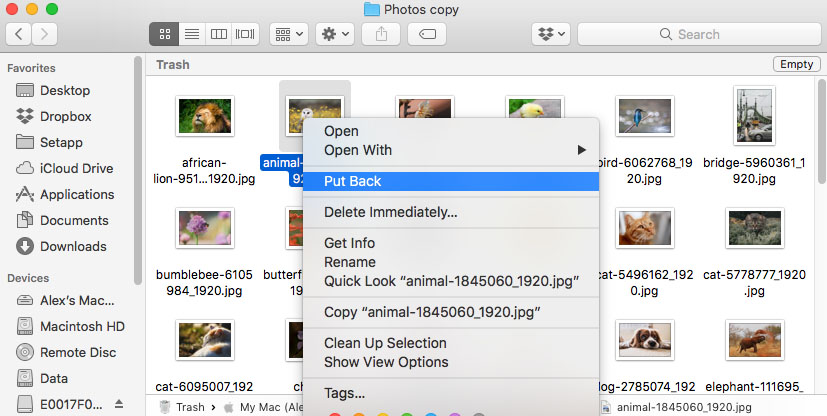
Method 2: Recover Deleted Files with Undo Options
👍 Advantages: Instant recovery of recently deleted files
👎 Disadvantages: Works only for a limited amount of time
You may be able to recover a deleted file by using the macOS Undo keystroke combination. In many cases, a combination of the Command and Z keys will undo your last action. If that action was deleting a file, performing the Command Z keystroke combination will immediately restore it. You may be able to go back several commands, but there is a limit so you need to try this method promptly after deleting the file.
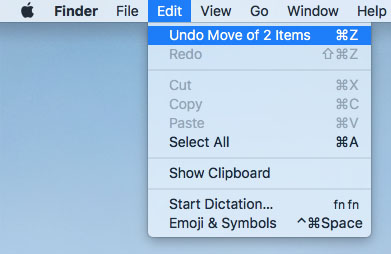
Method 3: Recover Deleted Files on Mac with the Terminal App
👍 Advantages: Good for users who prefer the command line
👎 Disadvantages: Not beginner-friendly
Following are two ways to recover deleted files on your Mac using the Terminal app.
- After opening Terminal through your Utilities on Mac, type the following command: cd .Trash and then hit Return.
- View the contents of the Trash folder with this command: ls -al ~/.Trash.

- Move files out of the Trash to the current folder with this command: mv filename ../.
- Enter Quit to exit Terminal.
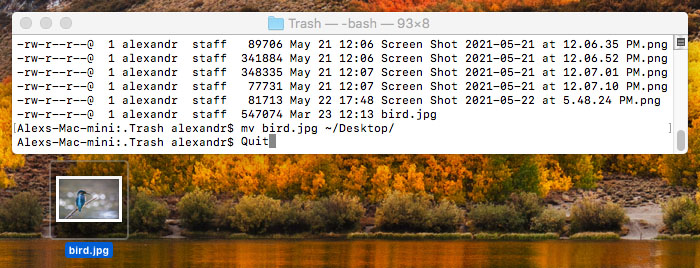
Method 4: Check .Trashes Folders
👍 Advantages: No need to install third-party software, quick & simple
👎 Disadvantages: Only for external storage devices, won’t help you recover permanently deleted files
Besides the main Trash folder, which can be accessed by clicking the Trash icon on the dock, macOS also creates a hidden .Trashes folder on every external storage device that you connect to your Mac, and it then uses this folder to temporarily store files deleted from the same external storage device.
Since .Trashes folders are hidden by default, most Mac users are not aware of their existence, which is a shame because the deleted files they contain can be easily recovered from them:
- Connect your external storage device to your Mac.
- Open Finder and navigate to the root folder of the external storage device.
- Press Command + Shift + . (dot) to display hidden files and folders.
- Open the .Trashes folder.
- Recover lost files from the folder.
You can then press Command + Shift + . (dot) in Finder again to hide hidden files and folders.
Method 5: How to Retrieve Deleted Files from a Time Machine Backup
👍 Advantages: Time Machine is part of macOS, can recover older versions of existing files
👎 Disadvantages: Requires previous setup, depends on an external backup drive
A Time Machine backup is a great way to recover a lost or deleted file. It is Apple’s free backup and recovery tool and comes preinstalled on your Mac. All you need to do is supply an external drive to store the backups. We strongly recommend that you use it to backup your valuable data.
The only problem with this method is that you need to have backed up the item to use this technique. It won’t work for recently created and deleted files or those that have had substantial changes made to them since the last backup.
Use the following steps to recover files from a Time Machine Backup:
- Connect the storage device that contains the Time Machine backup files to your computer.
- Open a Finder window in the folder that previously stored the file you want to recover. You don’t need a Finder window if the item was deleted from the desktop.
- Launch Time Machine by clicking the Time Machine icon on the menu bar.
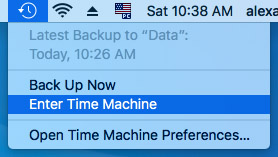
- Search through the available backups using the timeline and arrows to find the file that you want to recover.
- Select the file you want to retrieve and click the Restore button. The item will be restored to its original location.

Method 6: Recover via Other Backup Solutions
👍 Advantages: Versatile, cloud backups can be accessed from anywhere
👎 Disadvantages: Require previous setup
Many other backup solutions exist and they can all be used to save the day when files get accidentally deleted. They can be categorized as either creating local or cloud backups and slightly different techniques are necessary when using them to recover files. Here are the general steps when using either type of backup.
Cloud
Use these steps when recovering data from cloud backup options like iCloud or Carbonite:
- Connect your computer to the Internet and access the cloud storage that holds your backups.
- Locate the files you want to restore.
- Transfer them over the network to your machine.

Local
Local backups can be created with a wide variety of tools. Disk Drill offers a free feature that creates byte-level backups that can be used to protect your data and recover it if needed. Recovering from local backups requires following this general process:
- Connect the storage device that holds the backup to your Mac.
- Start the recovery tool or search on the backup media for the desired files.
- Copy the files from the backup media to your computer.
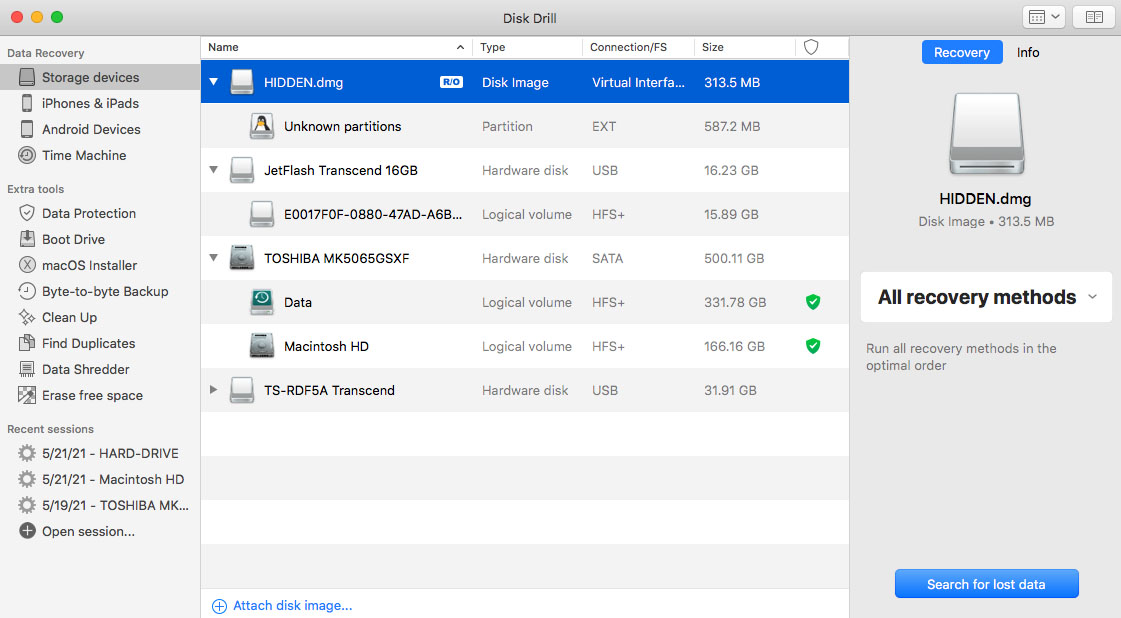
Method 7: Restore Permanently Deleted Files on Mac using Software
👍 Advantages: Doesn’t require previous setup, can recover permanently deleted files
👎 Disadvantages: A license is typically required for unlimited recovery
Data recovery software can be used to restore deleted files that are not in the Trash or have not been backed up. It can get back files that appeared to be permanently deleted from your Mac, as long as you act quickly before. The data is overwritten.
There are many different recovery tools available like Disk Drill, PhotoRec, EaseUS, and R-Studio. We chose Disk Drill for this demonstration and use it for our recovery needs. We like it because of its intuitive interface, advanced scanning algorithms, and compatibility with all major file formats and any type of disk-based storage device.
The following steps demonstrate how to recover deleted files on a Mac with data recovery software:
- Download and install Disk Drill for Mac. Don’t download and install the software on the storage device that contained the files you want to recover. If the data was lost on your main drive, use an external device for the download and install process. This will help prevent the files you want to restore from inadvertently being overwritten.
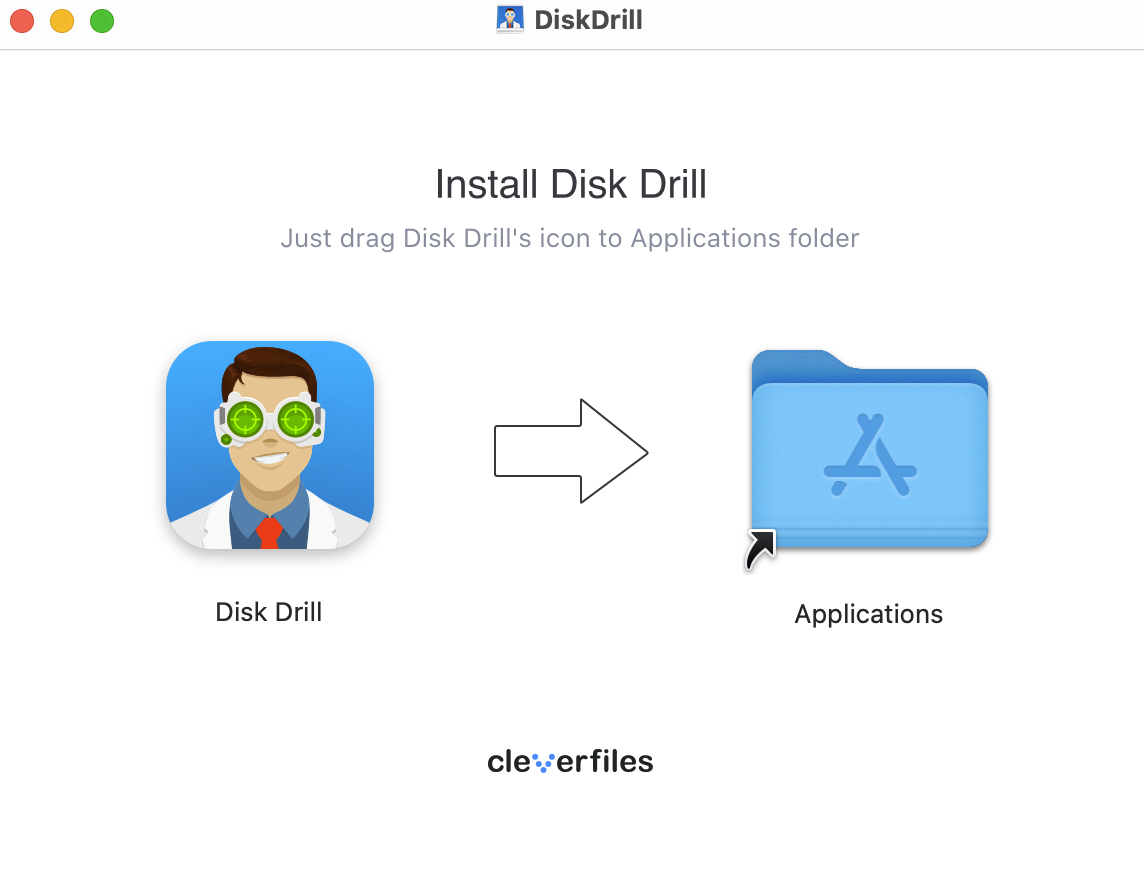
- Start Disk Drill and choose the affected device from the list of available disks.
- Click the Search for lost data button to start scanning the device for recoverable data.
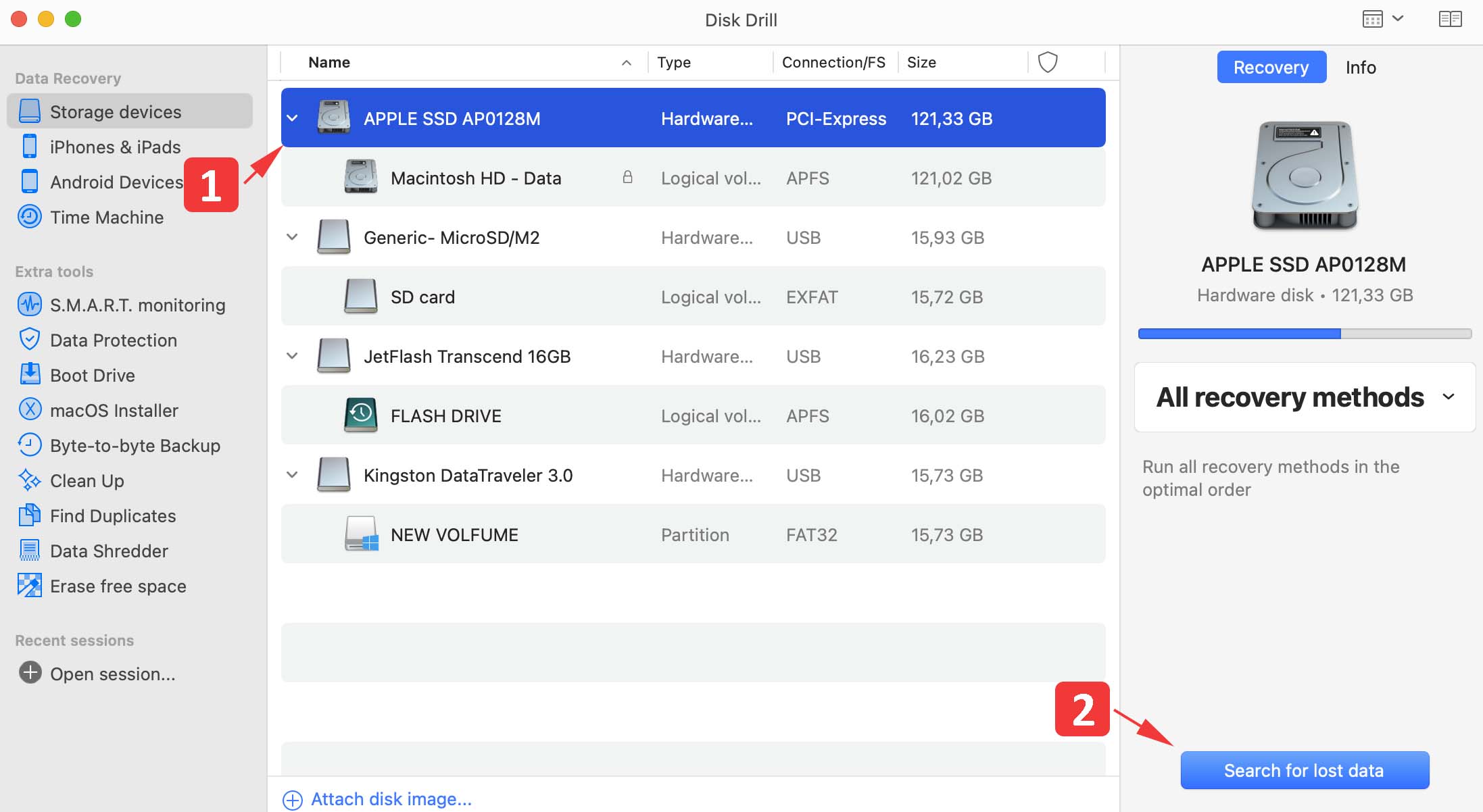
- Preview the files that Disk Drill finds and choose the ones you want to recover.
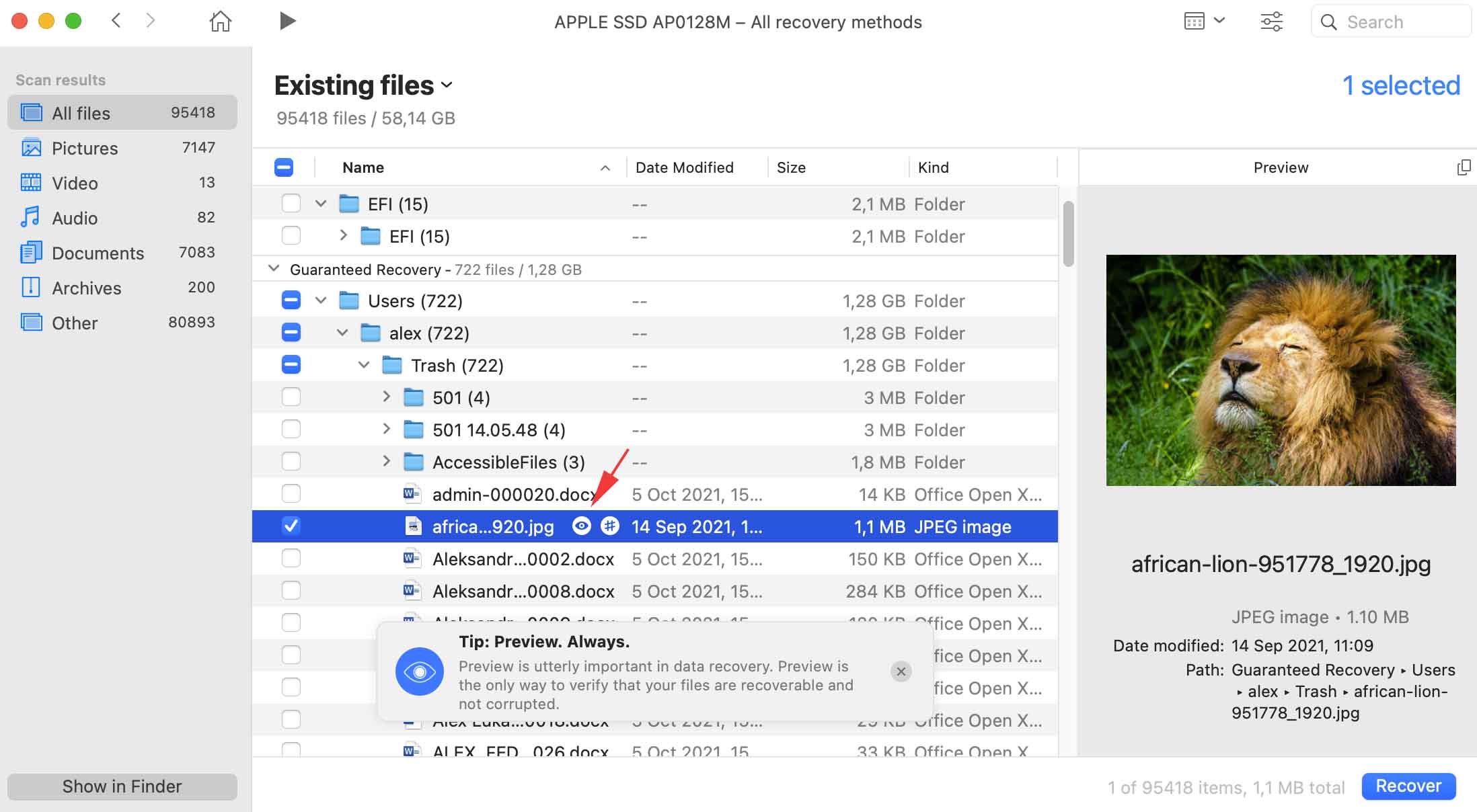
- Click Recover button and select a safe location to store the recovered data that is not on the original disk.
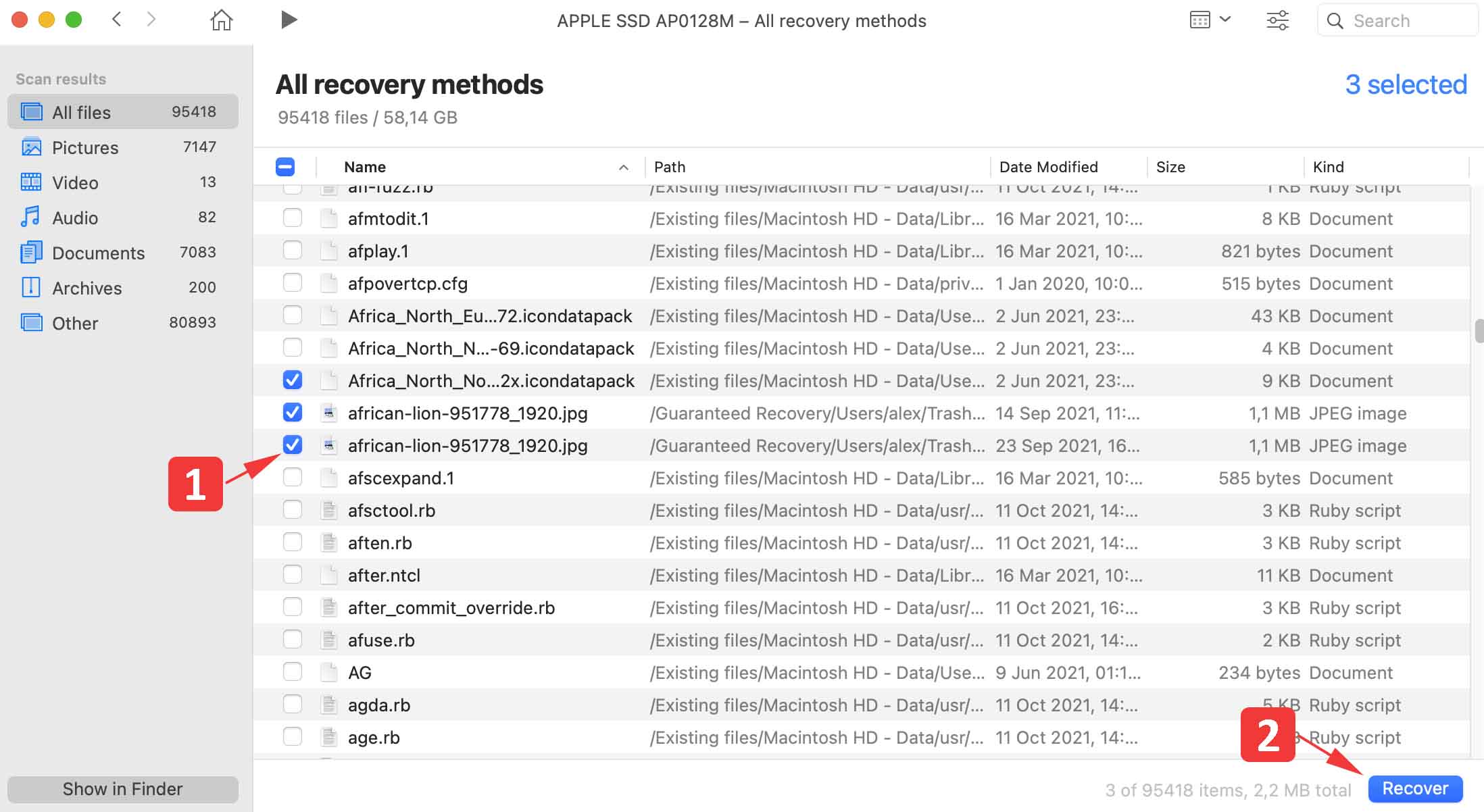
- Click the OK button to complete the recovery.
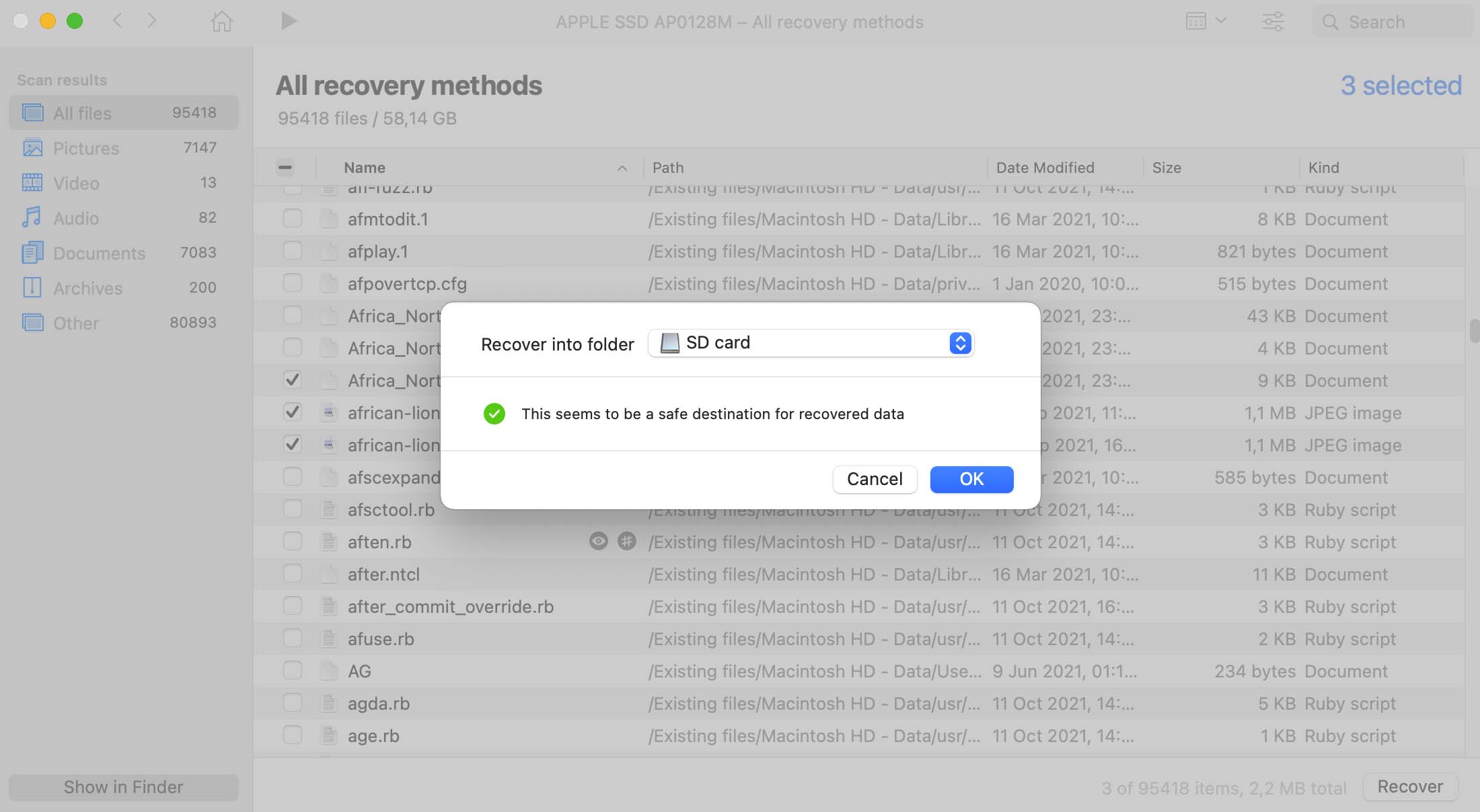
Method 8. Use a data recovery service

👍 Advantages: Can recover data from physically damaged storage devices
👎 Disadvantages: Expensive and potentially time-consuming
When all other options fail, a reputable data recovery service may be able to get your deleted data back. The specialists at a data recovery center use a cleanroom and advanced software and hardware techniques to recover your data. In cases of physical damage to the device, this may be your only choice.
If you have lost important data and cannot get it back using other methods, you should look into engaging a data recovery service. Here’s how it works.
- Contact the data recovery service for an initial consultation and to obtain shipping information.
- Send the storage device to the recovery center. Once it is received, technicians can evaluate the device and give you a recovery estimate.
- Specialists at the recovery center will open the drive and attempt to clone it to recover its data.
- Recovered data will be sent back to you on new media when the process is complete.
How to Avoid Data Loss on Your Mac
Even better than recovering your data successfully is not losing it in the first place. Here are some steps you should take to avoid losing valuable data stored on your Mac.
- 💽 Take backups regularly. If you are not currently backing up your Mac, we suggest you start today. Time Machine is already on your Mac and ready to use with an external drive. Other backup solutions can also work. Any backups are better than none, so get on it!
- 🤔 Take care when deleting files or formatting partitions and disk drives. Double-check your work before hitting that delete or format button. It might save you a lot of time later.
- 👾 Malware infections can result in data loss. Make sure you use an antivirus program on your Mac. Avoid connecting external devices that may contain a virus to your computer.
Common Causes of Mac File Loss
It would be impossible for us to list all causes of Mac file loss, so here are just five hand-picked examples to illustrate that data loss may come from all directions:
- User errors: The Sun will freeze sooner than users stop making errors. While macOS does have features that should theoretically prevent user errors from resulting data loss, experience tells us that they’re not always enough.
- Failed updates: A lot can go wrong when installing system updates, especially when testing beta versions of macOS. In extreme cases, a failed update may even leave your Mac unbootable, making it difficult to access the files stored on it.
- Hardware problems: Modern storage devices are, unfortunately, not perfectly reliable, and the same can be said about Mac computers in general. When a hardware component fails, the resulting data loss can be devastating, and only data recovery professionals are typically equipped well enough to solve it.
- Software bugs: Seasoned software developers know that all complex software contains bugs, and some particularly nasty bugs can lead to data loss, such as those that make applications crash unexpectedly.
- Power outages: Unless you work on a laptop or use an uninterruptible power supply, you’re exposed to the risk of data loss caused by a sudden power outage. For some reason, power outages tend to happen at the worst possible moment, which is why they so often make hours of work go to waste.
Conclusion
As you can see, there are many ways to recover a deleted file from your Mac. The simplest method is to recover files from the Trash on your Mac, but backups and data recovery software are also viable techniques. It’s important to act quickly to avoid the chance that your lost file gets overwritten by new data.
Data recovery software is the most reliable way to recover deleted files that are no longer available in the Trash. We recommend you stop using your computer until after the recovery is complete for the best results. Good luck recovering your lost data!
FAQs
The most reliable way of recovering permanently deleted files from a Mac is with data recovery software like Disk Drill, PhotoRec, or R-Studio. The basic procedures are the same for all data recovery solutions and involve the following steps.
- Install the software and connect an external storage device if necessary.
- Scan the affected storage device for recoverable files.
- Preview the identified files and select those to be recovered.
- Choose a safe storage location for the recovered data.
- Complete the recovery.
Without using data recovery software, your best option for recovering permanently deleted files are from a Time Machine or other form of backup. Use this procedure with Time Machine:
- Open a Finder window in the folder that contained the lost item.
- Start Time Machine.
- Search for the file with the arrows in Time Machine.
- Select the file you want and click Recover.



